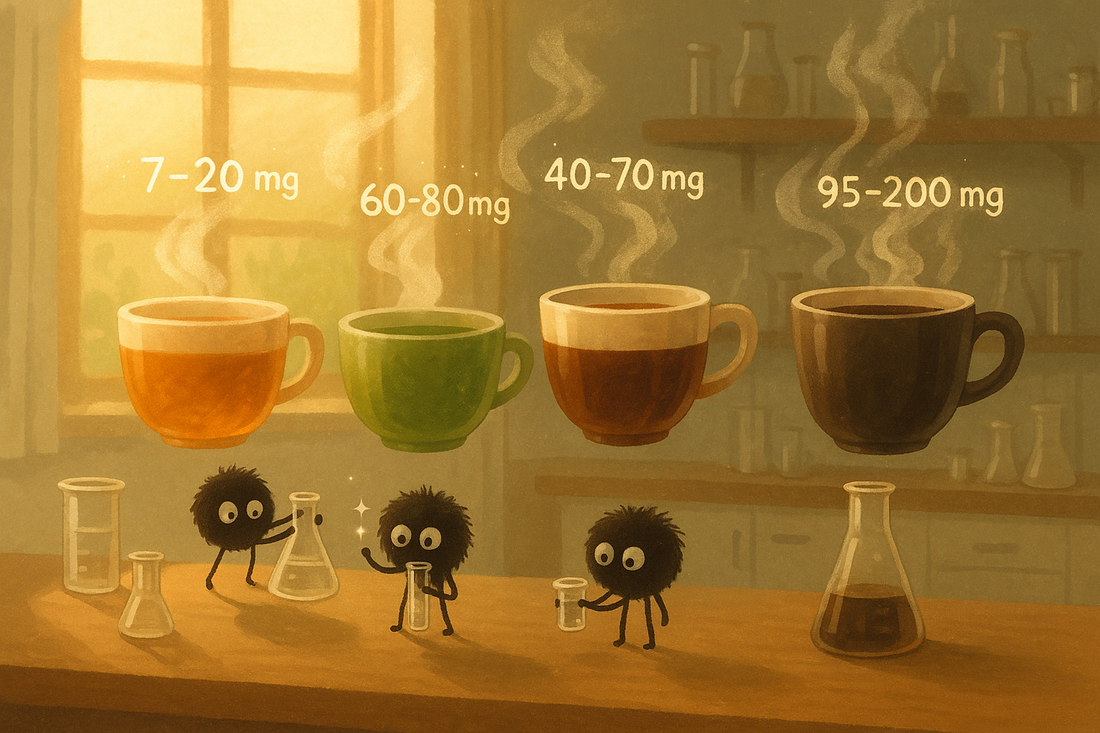
Hojicha Caffeine: The Complete Chart vs Coffee, Matcha & Black Tea
Hojicha Lab Guide
Short answer: hojicha is one of the lowest-caffeine everyday teas. Thanks to its gentle roast and calming amino acids, many people enjoy it in the afternoon and evening as a soothing alternative to coffee or matcha. Below is an easy comparison chart, followed by a practical guide to brewing for even less caffeine—and a simple plan to switch from coffee without the jitters.
What is the caffeine in hojicha?
Hojicha is a Japanese roasted green tea. Unlike matcha or unroasted green teas, hojicha is heated over high heat after steaming, which changes flavor, aroma, and how caffeine extracts into your cup.
- Leaf choice: Many classic hojicha styles use later-season or larger leaves, stems, and twigs (kuki-hojicha). Stems naturally contain less caffeine than buds.
- Roasting: Roasting alters some leaf compounds and reduces perceived sharpness, making the liquor smoother even when caffeine is present.
In everyday terms, a standard 8 oz cup of hojicha typically lands much lower in caffeine than black tea and dramatically lower than drip coffee.
Milligrams per 8 oz: Hojicha vs Matcha, Black Tea & Drip Coffee
| Beverage | Typical caffeine (mg) | Assumptions |
|---|---|---|
| Hojicha | 7–20 | 2 g tea, 1–2 min at 90–95 °C |
| Matcha | 60–80 | 2 g powder whisked; whole leaf consumed |
| Black tea | 40–70 | 2 g, 3–4 min at ~95 °C |
| Drip coffee | 95–200 | ~14–18 g grounds per cup |
Note: Cold brewing and shorter steeps generally extract less caffeine.
Why hojicha feels calmer
L-theanine balances stimulation
Green teas contain L-theanine, an amino acid that promotes relaxed alertness, smoothing the edges of caffeine.
Roasting reshapes the experience
Hojicha’s roast builds warm, caramelized aromas, reducing the perceived intensity of stimulation.
Lower absolute caffeine
As the chart shows, hojicha usually contains a fraction of the caffeine found in drip coffee and matcha.
How brew time & ratios change caffeine
- Leaf-to-water ratio: More leaf → more caffeine. For gentler cups: ~2 g per 8 oz.
- Time: Longer steeps extract more caffeine. Try 45–60 seconds for very low caffeine.
- Temperature: Hotter water extracts faster. Use ~85–90 °C for a softer cup.
- Cold brew: Extracts less caffeine, yielding a silky drink ideal for evenings.
- Leaf type: Stem-heavy kuki-hojicha is typically lower in caffeine than leaf-only grades.
Who should limit caffeine— even with hojicha?
- Pregnant or breastfeeding individuals (check guidelines).
- People with caffeine sensitivity.
- Evening tea drinkers prone to sleep disruption.
- Those on medications where caffeine is advised against.
How to switch from coffee to hojicha
Days 1–2: Swap the afternoon
Keep your morning coffee, but replace your second coffee with a cup of hojicha.
Days 3–4: Half-caf morning
Mix half coffee, half strong hojicha concentrate for your morning cup.
Days 5–6: Hojicha mornings
Switch fully to hojicha in the morning; adjust strength to taste.
Day 7: Lock the routine
Choose your preferred hojicha style and keep cold brew on hand for evenings.
Brewing hojicha for the lowest caffeine
- ~2 g leaf per 8 oz
- Steep 45–90 seconds at 85–90 °C
- Prefer kuki-hojicha
- Try cold brew for 4–8 hours
- Skip re-steeps if sensitive
FAQ
Is hojicha lower in caffeine than matcha?
Yes. Matcha averages 60–80 mg per cup; hojicha averages 7–20 mg.
Can I drink hojicha at night?
Yes, especially with short or cold steeps.
Does milk change caffeine?
No, but it can mellow perceived strength.
Is powdered hojicha higher in caffeine?
It can be, since you consume the particles.
Which has more caffeine—black tea or hojicha?
Black tea has several times more caffeine per cup.